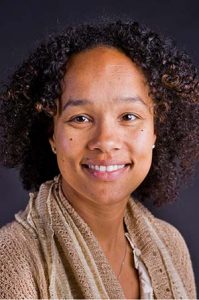The Vaccine Is Coming, and Scientists Need to Keep the Focus on Equity

Michele Andrasik, PhD. Director, Social & Behavioral Sciences and Community Engagement,
HIV Vaccine Trials Network at Fred Hutch; Clinical Assistant Professor, Global Health, University of Washington
As we navigate this pandemic, the discourse has often created a fog.
Science has been doing what it does – forming hypotheses, testing them, gathering vast amounts of data, and pressure-testing conclusions with unprecedented urgency. The ideas that pass scrutiny are being elevated into recommendations, while others are being discarded.
Science isn’t perfect. It is practiced by people, and people have flaws and biases. Communities of Color and other marginalized groups have been leaders in advocating for and securing the establishment of safeguards to reduce bias, increase inclusion and ensure the ethical conduct of science.
The HIV epidemic, where I have focused most of my scientific career, certainly was influenced by politics. This pandemic has been mired in an even more difficult stew of political ideologies, the need to continue operating the economy, and starkly different views about the limits of personal choice.
Lately, I’ve noticed more frequent rays of light shining through during this divided year. Public discussions this fall have begun to more often center on the larger public health implications and the personal and emotional impact experienced by those most impacted by COVID-19.
For example, witness the evolving discussion about school reopening, especially for young children, as we begin to better understand the risk they present of COVID-19 transmission, and the increasing risk of social, educational, and emotional delays they are suffering from school closures.
In December 2019, when the news was first announced that a novel virus that was spread through respiratory droplets was discovered and multiple cases confirmed, I braced myself.
I knew what this meant for my community and communities of color across the US. We were going to be hit and we were going to be hit hard. Numerous opportunities for exposure to a virus that spreads this way exist for communities of color.
Greater percentages of people of color work in essential service occupations. Disproportionate numbers live in high-density housing, which increases close contact with others and creates more possibilities for exposure and transmission.
More people of color live in multigenerational households. This places our elders at greater risk, because they are in more frequent contact with younger family members. Many racial and ethnic minorities are especially vulnerable to this virus because of higher rates of pre-existing conditions, lack of insurance and limited access to quality health care.
It is no surprise that nine months into the pandemic, communities of color are severely disproportionately impacted – greater cases of coronavirus infection, more instances of severe COVID-19 disease requiring hospitalization and a higher burden of mortality. The disparities persist as the COVID numbers continue to grow exponentially in the US.
Several weeks ago, we received the incredibly promising news that the Pfizer mRNA vaccine demonstrated over 90% efficacy in the prevention of COVID disease. This was followed a week later by a similar announcement by Moderna, another mRNA vaccine developer.
These developments have the potential to substantially ease the burden and address the disproportionate impact of COVID disease in communities of color.
To achieve this goal — of bringing the pandemic to an end for everyone — we must, as a scientific community, continue to prove that we are trustworthy.
That starts with communication. We need to provide information as soon as we have it, and ensure that we are forthright, transparent, and honest about what we know, what we don’t know and what we hope to learn as we obtain additional data.
As the Emergency Use Authorizations roll out, it is imperative that we discuss the allocation of vaccines with transparency. This requires being mindful in our explanations of what emergency use entails and ensuring that we offer resources that will help providers and the general public make informed decisions. Mandates for vaccination won’t work, but clear communication about the benefits of vaccination will allow people to come to their own conclusions.
Ensuring that the information we provide is written in clear language, inclusive of diverse communities, and respectful of everyone is critical.
Efforts to ensure that the efficacy data results are well understood should be at the foundation of these bi-directional dialogues with community.
In our recent discussions about efficacy results with communities of color in Washington state and around the country, it has become abundantly clear that many do not understand the data. There is some confusion about the prevention of illness versus the prevention of infection.
It is imperative that we effectively communicate that efficacy (at least according to the Phase III Pfizer and Moderna vaccine results) indicates the prevention of severe COVID-19 disease. That will greatly reduce hospitalizations and death but will not translate into relaxing infection prevention measures.
The vaccines may be effective at preventing people from shedding and transmitting the virus, but we don’t know that yet, so this remains an important open question. This means that ongoing messaging about the importance of wearing masks, physically distancing and avoiding congregating in large groups is critical.
Given that these early vaccines will prevent severe disease and death, ongoing education about who is at most risk for severe disease progression is imperative.
Risk for severe COVID-19 disease must be utilized to inform allocation decisions and the rationale for doing so must be highlighted as transparently as possible. The CDC’s Advisory Committee on Immunization Practices has followed a process along these lines – although these are recommendations. States, territories and the District of Columbia will be making their own decisions regarding allocation.
To address vaccine misgivings and questions about trustworthiness, we must clearly communicate the ever-changing vaccine landscape. This includes addressing concerns about availability and distribution. This requires preparing communities for the potential scarcity of vaccines in early 2021, setting clear expectations about vaccine availability and providing transparent information about how long the period of vaccine scarcity is likely to last.
Ongoing communication about vaccine safety and the actions being taken to assure vaccine safety must be a top priority. News of side effects are bound to spread around the world in minutes – whether they are serious concerns or not. See the two reported cases of anaphylaxis in the UK – it’s a concern that requires further monitoring and investigation.
This continuous monitoring for new signals as we engage in long term follow-up of vaccines, must be placed into the broader context of the vaccine’s safety and efficacy, and be accompanied by continuous education about what to expect upon vaccination.
What side effects are expected? Are they generally mild, moderate or severe? What is the vaccine efficacy after the first vaccination? Why are two shots needed for adequate efficacy? What will it mean if only one shot is taken? Why do I need to continue to take action to ensure reductions in the spread of the virus even after I am vaccinated?
All of these questions and the many more that will, undoubtedly arise, require the provision of direct and clear answers to secure trust and effectively address vaccine hesitancy.
Our reality will continue to shift as we obtain new data informing our path forward. Community members, scientists, essential workers, Americans are in this together. It will take all of us to move the science forward to see an end to this pandemic.
Along the way we must continue to engage in open dialogue, sharing information as it becomes available, being transparent about what we know and what we don’t know.
In my lifetime, I have never seen a time wherein there was such a collective sustained focus on equity, inclusion, and social justice. Over the past year, I have seen the acknowledgement of, and importantly, the accompanying work, necessary to address supply chain issues, tribal sovereignty and data ownership and the effective utilization of the capacity, expertise and leadership of long-standing institutions serving communities of color.
This is progress.
The work must continue, and is continuing. Relationship building and strengthening partnerships among institutions, organizations and communities must be centered as we continue transparent communication and ensure that all of us have the resources we need to make informed decisions. Our group has done work with organizations like the YWCA, UnidosUS, the Mexican Consulate, the Urban League, numerous faith-based organizations and the Urban Indian Health Institute, and we believe these relationships will help establish a strong foundation for improving health during the pandemic – and potentially long after it’s over.
In the coming months, we will be presented with many opportunities to demonstrate mindful implementation of an effective public health intervention. Working together with a focus on strong communication, transparency and trustworthiness will help to ensure that all of us — particularly those most impacted — are protected.
Michele Andrasik, PhD is the director of social & behavioral sciences and community engagement for the HIV Vaccine Trials Network at the Fred Hutchinson Cancer Research Center and a clinical assistant professor of global health at the University of Washington.




